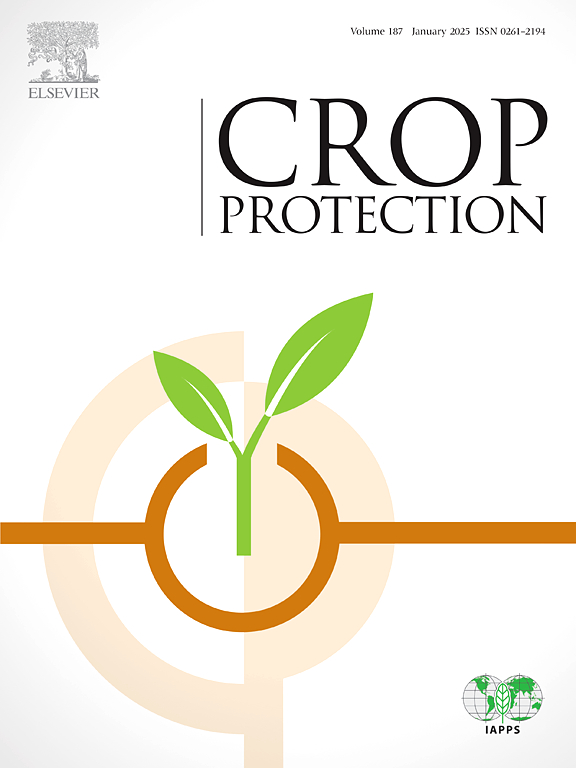Isolation and identification of Diaporthe phoenicicola causing leaf spot on Rosa roxburghii in China
IF 2.5
2区 农林科学
Q1 AGRONOMY
引用次数: 0
Abstract
Rosa roxburghii Tratt is commonly found growing wild in the south China. In recent years, it has been extensively cultivated in Guizhou, Sichuan, and Chongqing. The fruit of Rosa roxburghii Tratt serves as a valuable resource for both medicinal and culinary purposes, with a long-standing history of use in China. Recently, a new leaf spot was found in the field survey of R. roxburghii in Guizhou Province. The pathogens were isolated and identified by conventional isolation methods, and three genes internal transcriptional spacer (ITS), β-microtubulin (TUB2) and translation elongation factor 1-a (EF1-a) were analyzed. Based on morphological characteristics and phylogenetic analyses, the pathogenic fungus was identified as Diaporthe phoenicicola. Pathogenicity test was confirmed by inoculating R. roxburghii cultivars under greenhouse conditions. All R. roxburghii plants inoculated with D.phoenicicola developed symptoms identical to those observed on naturally infected plants in the field. The fungus were reisolated from the diseased leaves and identified as D.phoenicicola based on its morphological and molecular characteristics, confirming Koch's postulates. To our knowledge, this is the first report of R. roxburghii leaf spot disease caused by D.phoenicicola in China. After being infected by leaf spot disease, the R. roxburghii will develop brown or black spots, which may weaken photosynthesis, cause premature leaf senescence and shedding, and reduce the plant's stress resistance. Therefore, this disease may become a threat to R. roxburghii production in China.
中国刺梨叶斑病病原菌的分离鉴定
刺梨是常见于中国南方的野生植物。近年来在贵州、四川、重庆等地广泛种植。刺梨的果实作为一种宝贵的药用和烹饪资源,在中国有着悠久的使用历史。近年来,在贵州野外调查中发现了一种新的刺梨叶斑病。采用常规分离方法对病原菌进行分离鉴定,并对其内部转录间隔物(ITS)、β-微管蛋白(TUB2)和翻译伸长因子1-a (EF1-a) 3个基因进行分析。根据形态特征和系统发育分析,鉴定病原真菌为Diaporthe phoenicola。在温室条件下接种不同品种的刺梨,证实了其致病性。所有接种了腓尼基弧菌的刺梨植株都出现了与田间自然感染植株相同的症状。从患病叶片中重新分离出真菌,根据其形态和分子特征鉴定为d.p icicola,证实了Koch的假设。据我们所知,这是国内首次报道由d.p niicicola引起的刺梨叶斑病。刺梨感染叶斑病后,会出现褐色或黑色斑点,这些斑点可能会削弱光合作用,导致叶片过早衰老和脱落,降低植株的抗逆性。因此,该病害可能会对中国的刺梨生产构成威胁。
本文章由计算机程序翻译,如有差异,请以英文原文为准。
求助全文
约1分钟内获得全文
求助全文
来源期刊

Crop Protection
农林科学-农艺学
CiteScore
6.10
自引率
3.60%
发文量
200
审稿时长
29 days
期刊介绍:
The Editors of Crop Protection especially welcome papers describing an interdisciplinary approach showing how different control strategies can be integrated into practical pest management programs, covering high and low input agricultural systems worldwide. Crop Protection particularly emphasizes the practical aspects of control in the field and for protected crops, and includes work which may lead in the near future to more effective control. The journal does not duplicate the many existing excellent biological science journals, which deal mainly with the more fundamental aspects of plant pathology, applied zoology and weed science. Crop Protection covers all practical aspects of pest, disease and weed control, including the following topics:
-Abiotic damage-
Agronomic control methods-
Assessment of pest and disease damage-
Molecular methods for the detection and assessment of pests and diseases-
Biological control-
Biorational pesticides-
Control of animal pests of world crops-
Control of diseases of crop plants caused by microorganisms-
Control of weeds and integrated management-
Economic considerations-
Effects of plant growth regulators-
Environmental benefits of reduced pesticide use-
Environmental effects of pesticides-
Epidemiology of pests and diseases in relation to control-
GM Crops, and genetic engineering applications-
Importance and control of postharvest crop losses-
Integrated control-
Interrelationships and compatibility among different control strategies-
Invasive species as they relate to implications for crop protection-
Pesticide application methods-
Pest management-
Phytobiomes for pest and disease control-
Resistance management-
Sampling and monitoring schemes for diseases, nematodes, pests and weeds.
 求助内容:
求助内容: 应助结果提醒方式:
应助结果提醒方式:


